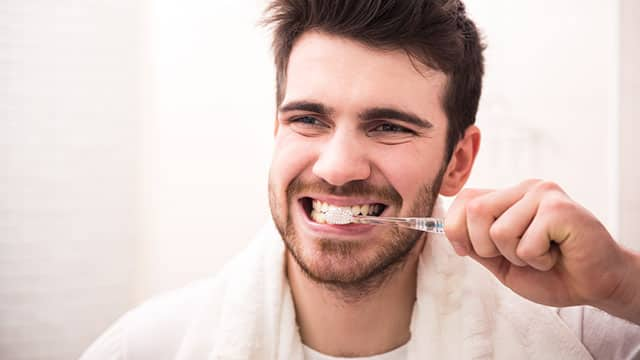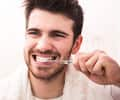What is Biofilm?
Biofilm is a layer of bacteria that can accumulate inside or on your body. The sticky white plaque that forms on your teeth and around your gums is a type of dental biofilm. Left untreated, biofilm can inflame your gums leading to gingivitis and gum disease.
Plaque needs to be removed because it can harden to tartar, also known as dental calculus, which can't be removed at home. Here are five biofilm removal methods you can start using today.
1. Brushing
Dental professionals recommend brushing your teeth with a soft-bristle toothbrush for at least two minutes, twice to three times a day, to remove plaque. Most people don't brush their teeth for that long, so biofilm can hide on your teeth and gum line. Brushing after meals and setting a timer for two minutes can help ensure you're brushing your teeth enough.
Choose a toothpaste with fluoride, like Colgate Total®. Fluoride interferes with the ability of plaque bacteria to produce harmful acids, and helps to restore minerals that those acids have removed from the tooth enamel.
When you're brushing, use short back-and-forth strokes or little circles to clean the outside surfaces, inside surfaces, and chewing surfaces of all of your teeth. Remember to brush around your gum line and your back teeth. These places are often skipped, so be diligent.
2. Flossing
Brushing alone won't remove all of the plaque since it can build up between your teeth or underneath your gum line, and it's tough to reach these areas with a toothbrush. To remove biofilm from these hard-to-reach areas, dentists recommend cleaning between your teeth once per day with floss, flossers, interdental brushes, water flossers, or other interdental cleaners.
Some people have difficulty using floss, but everyone needs to clean between their teeth. If you have limited mobility, large spaces between your teeth, or if you wear braces, ask your dental professional about alternative flossing methods. If in doubt, ask for a demonstration to ensure you're doing it correctly.
3. Professional Cleanings
Professional cleanings are an important part of biofilm removal. Even if you brush and floss regularly, you may not fully remove the bacteria. When it remains on your teeth, you could suffer from oral health problems like gum disease.
As a general rule, you should have a professional cleaning every six months. However, your dentist may prescribe more frequent visits depending on your oral health.
During a professional cleaning, your dental professional will carefully remove plaque and tartar from above and below your gum line with special instruments. They may also floss between your teeth to get rid of any hidden plaque.
4. Mouthwash
In addition to freshening your breath, some mouthwashes contain ingredients that can help to prevent or remove biofilm on the teeth. Colgate® Ortho Defense® Phos-Flur Mint, for example, contains fluoride, an anti-plaque ingredient. Fluoride also helps to strengthen your tooth enamel and protect against cavities caused by plaque.
Try to rinse with mouthwash at least once a day. It’s best to wait a little while after toothbrushing to do this, as you don’t want to rinse away the protective fluoride from your toothpaste.
5. Diet & Lifestyle
The bacteria in biofilm feed on the sugars from your diet. This includes obvious culprits like cakes, candy and soda, but also starchy foods like chips, bread and crackers. To keep plaque at bay, try to enjoy these foods and drinks in moderation.
Smoking tobacco also contributes to plaque build-up. It alters the bacterial make-up of your mouth and restricts oxygen flow to the gums, making it easier for plaque bacteria to thrive. If you’re a smoker, quitting is a powerful way to improve both your oral and general health. Ask your medical or dental professional for support.
Can biofilm be fully removed?
With twice-daily brushing using a fluoride toothpaste, along with interdental cleaning, you can remove biofilm that builds up throughout the day. However, if you have heavy plaque and tartar, it can only be fully removed by a dental professional.
What gets rid of biofilm in the mouth?
To help get rid of plaque, your dental professional may recommend products with antimicrobial agents, such as chlorhexidine gluconate, although you should only use these if recommended. Once plaque has hardened to tartar, it can only be broken down and removed by your dental professional.
Be cautious of “natural” biofilm removal methods, such as essential oils or apple cider vinegar, as the safety and effectiveness can vary greatly. If in doubt, ask your dental professional.
What does biofilm look like in the mouth?
Plaque is a white-ish substance that might be hard to see on your teeth in small amounts. It may be most obvious near to your gum line or in the spaces between your teeth. As plaque matures and hardens into tartar, it can take on an off-white, yellow, brown, or even black color. It may look like stains or a thick, hard layer on the teeth.
Biofilm can cause oral health problems, so it needs to be removed promptly. A good oral hygiene routine that includes brushing, interdental cleaning and regular visits to your dental professionals for professional cleanings will help you effectively remove plaque and keep your mouth healthy.
This article is intended to promote understanding of and knowledge about general oral health topics. It is not intended to be a substitute for professional advice, diagnosis or treatment. Always seek the advice of your dentist or other qualified healthcare provider with any questions you may have regarding a medical condition or treatment.
ORAL HEALTH QUIZ
What's behind your smile?
Take our Oral Health assessment to get the most from your oral care routine
ORAL HEALTH QUIZ
What's behind your smile?
Take our Oral Health assessment to get the most from your oral care routine
Join Us
Get the best of your oral health routine and take it to the next level with expert advice, recommendations, products and solutions and special offers.
Join Us
Get the best of your oral health routine and take it to the next level with expert advice, recommendations, products and solutions and special offers.















